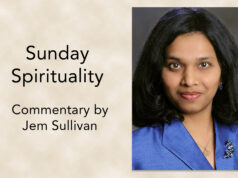Like the pooka and the kelpie, St. Brigid of Kildare may have been a mythical Celtic creature — or she may be one of the holiest women who ever lived in Ireland. As with all things Irish, her story is a colorful one, full of embellishments.
The question of her actual existence arises because later scholars who studied both St. Brigid and Celtic mythology saw similarities in the lives of both the saint and the Celtic goddess of the same name. There is speculation that missionaries attributed the qualities of the goddess to the Irish nun in an effort to easily convert the pagan people of Ireland.
Regardless, as Catholics, here is some of what we know about St. Brigid of Kildare.

She was born in 451 AD to a Christian slave named Brocca, who had been impregnated by her owner, Dubthack, a pagan chieftan, in Dundalk, County Louth. When Dubthach’s wife discovered that Brocca was pregnant, she had the woman sold to a Druid landowner. Brigid was born into slavery, but her powerful mystical ways began to manifest in infancy. One legend says that she would not allow the Druid to feed her because he was impure; allegedly a white cow mysteriously appeared and it’s milk was used to feed the baby instead.
At the age of ten, Brigid was returned to her father’s household, where she engaged in the pious but annoying habit of giving away his belongings to the poor.
When she was older, Brigid expressed a desire for religious life. Her father disapproved and tried to arrange a marriage for her to a wealthy man. Legend says Brigid prayed for her beauty to wane so that the man would not be interested in her, and her prayers were answered. Her diminished looks meant the marriage never happened and after she joined the convent, it’s said that her beauty returned.
As a religious, Brigid was known for her charismatic leadership. In the year 480, Brigid founded a monastery at Kildare on the very site of a shrine to the pagan Brigid. She is credited for being the woman who implemented the concept of consecrated religious life for women in Ireland. She also founded an art school, where the arts, including metalwork and manuscript illumination, were taught.
Many Irish homes have a square Brigid’s Cross hanging on their front door for protection. It’s said that while Brigid was tending to a pagan on his deathbed, she told the story of Jesus on the cross, all the while weaving a cross of rushes to illustrate her story. When she finished the cross, the pagan immediately asked to be baptized.
Many miraculous happenings are attributed to Brigid. One story says that she once gave away her mother’s entire store of butter, but it was mysteriously replenished. Legend said that when Brigid prayed, she could stop the wind and the rain. It was also said that Brigid could turn water into beer. She once travelled to Leinster and stayed at the house of a family who had two mute daughters. Apparently, just a touch from Brigid’s hand healed the girls of their afflictions. When a woman once criticized Brigid for giving away fruit to lepers, Brigid cursed her trees so they bore no more fruit, yet blessed the trees of another woman in the same town who was generous to the poor with the harvest from her orchards.
One of the cleverest stories about St. Brigid tells of the time she asked a powerful man for land to build a monastery. He first refused, then complied, mocking her by saying he would give her land the size of her cloak. Of course, when the cloak was spread out by her fellow sisters, it covered acres, and the miraculous joke was on the rich man.
Brigid was held in such high regard that when she was near death, she was given last rites by St. Ninnidh, who then encased his hand in a metal glove so it would never touch another.
She died at age 75 on Feb. 1 — coincidentally the pagan feast of Imbolc and the goddess Brigid — and was buried in Kildare in one of the many monasteries that she had built. Years later during the Scandinavian raids on the British Isles when Vikings destroyed churches and holy objects, her remains were moved to County Down to rest with the other patron saints of Ireland, Patrick and Columcille.
St. Brigid’s feast day is Feb. 1
She is the patron saint of many things, among them dairymaids, midwives, brewers, blacksmiths, pressmen, and children born out of wedlock.
Great article from the Irish Times here:
https://www.irishtimes.com/news/brigid-unbound-1.130874
A prayer to St. Brigid can be found here:
http://www.stagnescathedral.org/Prayers/St%20Brigid.html







